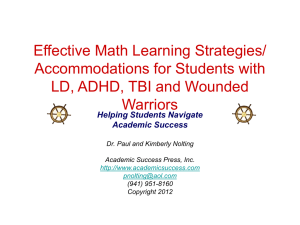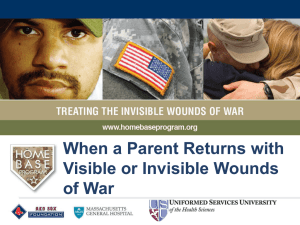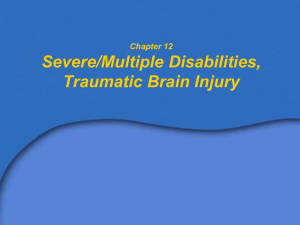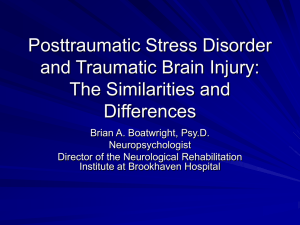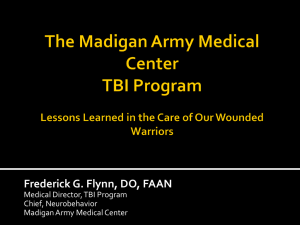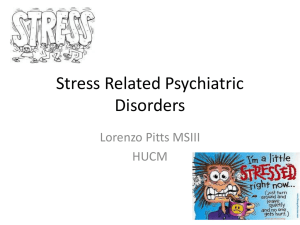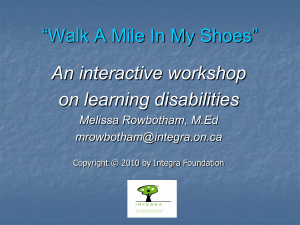Definition
advertisement
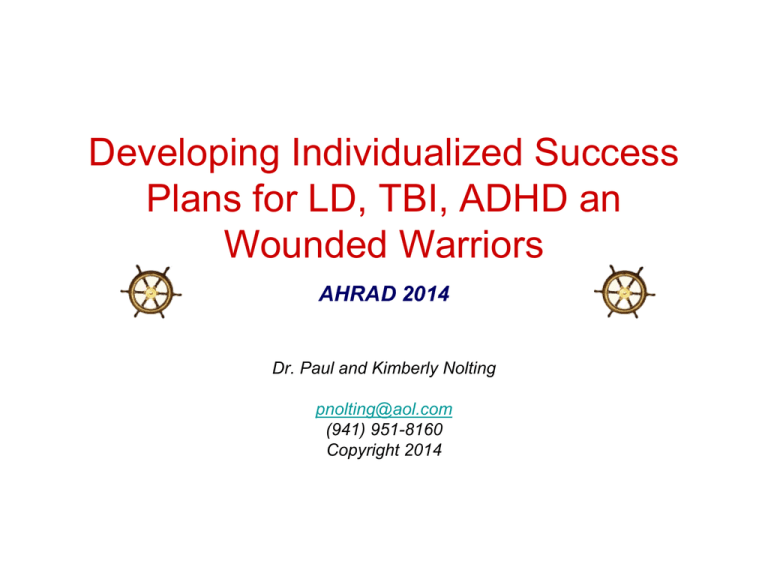
Developing Individualized Success Plans for LD, TBI, ADHD an Wounded Warriors AHRAD 2014 Dr. Paul and Kimberly Nolting pnolting@aol.com (941) 951-8160 Copyright 2014 Agenda Informal Quiz Processing Deficits and Their Effects on the Learning Process Learning & Memory Processing Difference ADHD, PTSD, TBI and MTBI Teaching/Tutoring Concerns – Best Practice Helping Students Process Math, Math Study Skills and developing – My Math Success Plan Learning Problems Affecting Math Grades Incorrect course placement Mismatch of teaching styles and course design Lack of math study skills Math and test anxiety Posttraumatic Stress Disorder (PTSD) - a life-threatening event like military combat, natural disasters, terrorist incidents, serious accidents, Learning Disability (LD) – neurological cognitive processing deficits in STM, WM, LTM or FR Traumatic Brain Injury (TBI)- STM, executive function, FR Attention Deficit Disorder (ADD) - executive function attention/concentration problems Not having a math success plan – Start plan now Students with Disabilities The Myths and Truths Myths Disabilities can go away Students with LD, ADHD, PTSD and TBI have low intelligence or are slow learners If they would just study harder or be exposed to more educational opportunities they would not be disabled Students with disabilities have the same learning problems. Disabilities can be cured. Disabilities do not exist. Truths • • • • • • Disabilities do not disappear but may range in expression and severity at different life stages By definition a student with LD has average to high intelligence. Disabilities are neurological in origin. They have a central nervous system basis. It doesn’t arise from lack of exposure to life experiences. There are many different disabilities that require different strategies. A student can have more than one disability type. Disabilities are permanent conditions. Disabilities do exist under ADA Definitions of Math and Other Disabilities Acalculia – inability to read or write numbers in that individuals can not perform calculations or having impaired spatial organization Dyscalculia – failure to develop math (arithmetic) competences that is not due to a brain injury or mental impairment Dysalgebria – students with average to above average IQ can master calculations but can not master algebra (Nolting, 2000). Dyslexia – is not a math learning disability but may cause math learning problems due to misreading or miscopying numbers and letters. Dysgraphia – is not a math disability but may cause math learning problems due to poor hand writing and copying from the board. PTSD Posttraumatic Stress Disorder can occur following a life-threatening event like military combat, natural disasters, terrorist incidents, serious accidents, or violent personal assaults like rape The traumatic events that lead to post-traumatic stress disorder are usually so overwhelming and frightening that they would upset anyone. Following a traumatic event, almost everyone experiences at least some of the symptoms of PTSD. Has to be more than 30 days. PTSD SHORT CIRCUITRY In spite of the evolution/adaptation of the brain over the eons, and the increasing awareness of the pre-frontal Cortex, when confronted by worries, stressful and traumatic events, the response skips back to more primitive times and jumps to the limbic system. • Intrusive, upsetting memories of the event • Flashbacks (acting or feeling like the event is happening again) • Nightmares (either of the event or of other frightening things) • Problems with Executive Function • Change biochemistry TBI and MTBI Acquired brain injury Violent hit to the head May or may not lose consciousness Movement of brain back and forth in skull Symptoms can be mild, moderate, severe Several MTBI is as bad as a TBI Can change biochemistry May or may not improve over time Silent disability and growing Stages of Memory Hand out • Sensory input is when an individual physically takes in the information. TBI, PTSD • Sensory register is when the mind neurologically accepts the information. TBI, PTSD, ADHD • Short-term Memory is when the brain receives information and stores it for a brief time. TBI, LD? Forgetting = Information not input or registered. Stages of Memory Working Memory is like RAM in a computer that can send or recall information and is part of executive function. TBI, PTSD, LD? Long-term memory is a storehouse of material that is retained for long periods of time. LD? Abstract Reasoning uses recalled concepts to make new meaning and understanding without using language. TBI, LD Memory Output is recall learned facts and/or concepts. TBI, PTSD Forgetting = Information not Understood Educational Information-Modality Styles Different preferences for inputting information When viewing learning as a sequence of events, modalities shape the first step of encoding information Auditory, visual, kinesthetic/tactile Auditory Processing Disorder Definition: Students with auditory process problems have difficulty synthesizing words and understanding words in noisy classrooms. These students may misinterpret words or not “hear” the words. This is not a hearing problem or short term memory problem. It is a problem of misinterpretation of words spoken words. Primary Affected Areas: sensory register, short term memory Observable Behaviors: students misunderstanding math vocabulary; difficulty solving word problems; difficulty reading the text and understanding lectures Processing Speed Disorder Definitions: Students with a visual speed processing disorder have great difficulty quickly recognizing numbers and conceptually similar visual objects. A student with visual speed processing disorder is able to visually process but very slowly. Primary Affected Areas: sensory input & register; significantly related to math & PTSD Common Observable Behaviors: re-reading sentences & paragraphs; scanty notes or no notes at all; very slow in completing homework, very slow in doing on line homework, very slow in completing tests, having difficulty quickly recognizing variables and math symbols, problems with automaticity Short-term Memory Processing Disorder Definition: Short-term memory disorder is categorized as auditory memory. It is the difficulty in keeping information in short term memory long enough to transfer it into working or long term memory. Also it is the automaticity of rearranging numbers in your head. Primary Affected Areas: Subsequent effects on the long-term retrieval, working memory, long term memory, and abstract reasoning. Students who cannot hold information for more than a few seconds cannot use it to rehearse or recall from working memory. TBI Observable Behaviors: Auditory: forget oral instructions; difficult to be group learner; ask questions about recent information; can’t hold on to steps long enough in mind to understand concept; difficulty in manipulating numbers in you head; difficulty in switching number in an equation presented verbally; some problems with abstract learning Visual-Spatial Thinking Processing Disorder Definitions: A student with a visual- spatial processing disorder has great difficulty in recognizing and synthesizing visual information. The student also has difficulty remembering visual information and remembering it in the correct order. Primary Affected Areas: sensory input & register; short term memory Common Observable Behaviors: re-reading sentences & paragraphs; “chicken scratch” notes or no notes at all; problem solutions all over the page; numbers miss-aligned; copying down incorrectly; difficulty reading tutor/instructor handwriting; facial gestures while looking at something; misreading variables and numbers such as b for d or 9 as a 6 or + for x Long-Term Retrieval Processing Disorders Definitions: Students with LTR disorders have minimal ability to input or retrieve information in active memory in order to understand concepts. The LTR process pertains to speed of putting information into/taking it out of long-term memory and abstract memory. Primary Affected Areas: Abstract/fluid reasoning, Longterm memory; Memory output; Any learning task that involves using several pieces of information or concepts; tired after a short period of studying. Related to TBI, PTSD Observable Behavior: Confusion on multiple step assignments; Brain Traffic Jam; spaced out look; student understands step by step problem solving but can not put all the steps together to solve the next problem. Working Memory Processing Disorders Definitions: Students with working memory disorders have minimal ability to retain a large amount of information in active memory in order to understand concepts. Students also have problems manipulating that information to solve problems. Low RAM Primary Affected Areas: Abstract/fluid reasoning, Long-term memory; Memory output; Any learning task that involves using complex pieces of information or concepts; math problems that require using multiple concepts at the same time to solve; significantly related to math TBI, PTSD Observable Behavior: Confusion on multiple step assignments; Student may understand each concept but can not organize the steps in order to solve the problem. tired and frustrated after a short period of studying Comprehension-Knowledge (LTM) Processing Disorders Definition: Students with long-term memory problems have minimal ability to store information for a long period of time. The length of time for which students can hold information may vary. For instance, a student may learn material during one monthly unit and not remember it during the next unit. On the other hand it could be that a student remembers how to work a math problem one day and then forget how to do it the next day. Primary Affected Areas: working memory, abstract reasoning and long term retrieval; significantly related to math Observable Behaviors: holes in the foundation of concepts needed for further learning --- have to relearn information but remembers bits and pieces Fluid /Abstract Reasoning Processing Disorder Definition: Abstract reasoning disorders keep students from being able to form concepts and solve abstract problems that include novel situations and extrapolating information. It is also the inability to identify relationships with unfamiliar concepts and making inferences. Primary Affected Areas: working memory, long term memory, memory output, all dependent on the level of critical thinking required highly significantly related to math- TBI Covalence Atomic structure Covalent bonding compared to ionic means... Electron s Observable Behaviors: need for repeated instruction as if information was never learned; repeated blank looks; ability to mimic processes but not apply them, not making inferential leaps; can’t generate alternate problem solving strategies Math Study Skills Content How Learning Math is Different How to Motivate Yourself to Learn The More Math You Take the More Money You Make Time Management and Creating a Positive Study Environment Improving Listening and Math Note-Taking Improving Math Reading and Homework Skills Improving Math Test-Taking Skills Understanding How Disabilities Affect Math Learning Understanding How Wounded Warriors Have Difficulty Learning Math Developing Individualized Math Success Plan or Math Mission Plan Math Study Skills Evaluation Joe College, the overall result of your evaluation is a score of 51. A score of 79 and below means you need to improve your math study skills and this could be the main reason you may have had having difficulty. Question #1 My habit is that I: A. seldom study math every school day. Your response indicates that you may not understand that math has a sequential learning pattern. A sequential learning pattern means material learned one day is used the next day and the next day and so forth. That means putting off studying math will lead to poor math grades. You need to study and do your homework before each class. You need to read pp. 11-21 in Math Study Skills Workbook Question #4 My habit is that I: C. almost always become anxious and forget important concepts during a math test. Your response indicates that you have symptoms of math anxiety and/or test anxiety. Math and test anxiety are learned responses, which can be unlearned. You need to learn how to control your anxiety by using relaxation techniques and positive self-statements during homework and tests. You need to read pp. 65-69 & pp. 72-79 in Math Study Skills Workbook. Class Note-taking System Three Column Method Math Problem Key Words/Rules/ Properties Examples/Problem Steps Explanations and questions I need to ask myself Test Anxiety: Myths Students are born with it. Test anxiety is a mental illness. Test anxiety cannot be reduced. Any level of test anxiety is bad. All students who are not prepared have test anxiety Students with test anxiety can’t learn math Students who are well prepared don’t have it. Intelligent students don’t have it. Attending class and doing homework should reduce it. Being told to relax will make you relaxed. Doing nothing about it will make it go away. Reducing test anxiety guarantees better grades. Tensing and Relaxing Technique Relax all your muscles. Tense your muscles. Pull up with your arms tight. Press down with you feet and legs. Hold for a few seconds. Relax. Repeat one more time if necessary. Ten Steps to Doing Online Homework 1. 2. 3. 4. Review related textbook material. Review appropriate lecture notes. Do homework neatly. Must write down problem and every problem step. 5. Understand reasons for problem steps instead of using the click and go method. 6. For difficult problems use the resources provided by the software (videos /tutor line). 7. Finish by working a problem successfully. 8. Recall or write down important concepts. 9. Develop virtual note cards by using www.studystack.com. 10. Don’t get behind – you could get block out. Learning from online homework is more difficult than text book homework Ten Steps for Taking Classroom or Online Tests 1. Memory Data Dump 2. Preview Test 3. 2nd Memory Data Dump 4. Test Progress Schedule 5. Answer Easy Questions 6. Skip Difficult Questions 7. Review Skipped Questions 8. Guess at Remaining Questions 9. Review All of the Test 10. Use all the Test Time “The first student done with the test may not be the smartest in the class. Often the smart students are the ones that take the entire time to make sure they do everything accurately. Be brave. Stay in the room and make sure you complete everything accurately.” Six Types of Test-taking Errors 1. 2. 3. 4. 5. 6. Misread Directions Careless Errors Concept Errors Application Errors Test Procedure Errors Study Errors This is why they invented the eraser! Teach Final Exam Perpetration Use the eraser wisely. Sometimes it is better to scratch something out at first and then make sure the correction is right. Go back and erase, leaving the correct information. Sometimes when we are nervous, we may change a correct a right answer. We erase the right answer, go on to other problems, check the test and discover we changed an answer incorrectly and have forgotten the right answer. Educational Accommodations Writing and Reading Mathematics 1. 2. 3. 4. 5. 6. 7. 8. 9. Graph paper Color assignment to different numerical functions and symbols Problem on left side of paper and extra math calculations on the right with line dividing down the middle Use of capital letters instead of small letters Lots of white space Students use whiteboard Test format with larger fonts and more white space Pictures/graphs for word problems Hands on Equations 1. 2. 3. 4. 5. 6. 7. 8. Computer programs with visual alterations Color coding parts of sentences, paragraphs Physically cut and paste Lots of white space Typing with large simple font Note cards for organization of paper and sentence structures Tests and readings with larger fonts and more white space. Pictures for organization of ideas Education Accommodations & Math Study Skills Teaching /Handout Accommodations 1. 2, 3. 4. 5. 6. 7. 8. 9. Vocabulary lists Formula sheets/cards Mental cheat sheets Three column note taking Lectures with immediate practice to break up the inputting time with rehearsal time. Structured, step by step process for reading the textbook Power point on during class for individual reference use during lecture (post on website) Class recitation Math Study Skills Evaluation, My Math Success Plan student workbook & Mathematics and Disability Handbook: Guide for Students with LD, ADHD, TBI, and Wounded Warriors-ebook. Tutoring 1. 2. 3. 4. 5. 6. 7. 8. Digital -record sequential steps or questions that the student and tutor have created Place same information on note cards Put information cues to music or rhythmic recitation Mental cheat sheets Construct tutoring session to include constant student verbal and/or visual feedback. Over and over Draw pictures for cueing Review and review Learning Assistance and Tutor Training Manual Math Testing Accommodations • • • • • • • • • Extended time Private quiet test area Formula sheet Fact sheet Key word list Lecture notes Clarification of test questions Manipulatives Scribe and white board Individual Math Success Plan Semester: Fall 2014 A. Student Information: Name: Paul College, Sophomore Disability: LD B. Services: Tutoring thee times a week 1 hr-, Word processing training with a reading program, meet with DSS counselor C. Courses: Beginning Algebra, History, English II, Biology Individual Math Success Plan D. Math Study Strategies: Use note-taking system , color code notes, develop a math glossary, use online note-taking system, learn relaxation techniques, use online test- taking system, analyze test results E. Educational/Testing Accommodations: Use smart phone to record parts of lectures and difficult tutored problems, extended test time, F:Disability Information: Strengths- language skills, short-term memory, long-term memory and motivation. Weaknesses – visual processing skills, visual memory, reading and math study skills G. Semester Goals: 3.0 GPA, B in math, improve math study skills, attend thee tutor sessions a week, use educational and testing accommodations, see my math instructor every two weeks. Math Mission Plan Semester: Fall 2014 A. Student Information: Name: John Doe, Sophomore Year in College: Freshman B. Services: I will do my homework in the Mat Lab M-F for 1 hour I will attend tutoring sessions thee times a week 1 hrI will meet my certifying office once a month C. Courses: Intermediate Algebra, History, English II, Biology Math Mission Plan D. Learning Information: Visual and hands on learner Attends all classes, Problems with auditory short-term memory, Problems with note taking, test taking and test anxiety E. Math Study Strategies: Learn the seven steps to math note taking Use a smart phone to take picture of the board, Compare notes with fellow student, Develop a “to do” list and review it every day, Practice relaxation techniques, Follow the Ten Steps to Test –Taking, use http://www.wolframalpha.com/ to check my homework F. Semester Goals: 3.0 GPA, B in math, Improve note-taking and math study skills, Study math 12 hours a week, Meet with my math instructor once a week, Review my math tests with the tutor or instructor, Keep up with my “to do” list, Reward myself for success Alternative Math Course Sequence • Elementary Algebra Statistics • Elementary Algebra Liberal Arts Math • Elementary Algebra Topics in Math Significant CHC Factors & Clinical Clusters for Course Substitution Working Memory Long-Term Memory Not Enough RAM Not Enough Facts Abstract Reasoning Not Enough Logic TBI, MTBI and PTSD – CHC and Clinical Clusters Can use research in Math and Disabilities Handbook (Nolting, 2012) to support accommodations and course substitutions Course Substitutions • Introduction to Computers • Accounting I • Environmental Science • Business math • Astronomy • Macro-economics • Philosophy • Earth and Space Science • Oceanography • Logic/Critical Thinking • Physical Science Collaboration of Departments and Centers to Improve Math Success Office of Students with Disabilities Math Department Learning Assistance Center Counseling/Advisement Center Veteran Center Administration Joint Student Workshops with ODS and Veteran Center Conclusion Each student with disabilities or wounded warrior is unique; therefore, it is important to continue learning about the processing deficits and how they affect learning in specific disciplines. As a result, an instructor or tutor can take the suggested strategies and adapt them to meet an individual’s special learning challenges. Let’s continue the conversation. Email us at Pnolting@aol.com whenever you have questions or when you have success stories!

